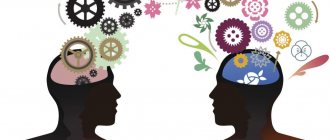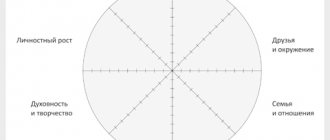Definition of the concept
Since the phenomenon of personality is a subject of study not only in psychology, but also in other humanities, the term does not have an unambiguous definition. For a better understanding of what a person is, three main definitions will be given below.
Personality is a set of individual qualities of a person (thinking, will, and so on) that determine his behavior in society, speak about his values, life experience, and aspirations.
In other words, the psychological difference between one individual and another characterizes his personality.
A person can be defined as a subject of society with a set of roles (social and personal), certain habits and experiences.
This term also refers to a person who is completely responsible for all aspects of his life.
Human individuality ↑
There are as many individuals as there are people, because each person is an individual.
The driving force for the development of individuality, its programming properties:
- Direction is the motivation of behavior and activity.
- Intelligence is a person’s ability to assess a situation, make a decision, and control their behavior.
- Self-awareness - this includes self-esteem (low, adequate, high) - attitude towards yourself and your actions; self-control – the ability to control one’s behavior and emotions.
There are also basic personality traits: temperament, character, abilities.
Personality structure
To better understand the term, it is worth considering its structure.
The structure of personality can be understood as the interaction of its component parts (character, aspirations, will, abilities, emotions). These parts (components) characterize a person; they can be called her traits. To structure these personality-defining traits, the following levels are distinguished:
- lower,
- second,
- third,
- higher.
The lowest level is the mental characteristics of a person determined by gender, age, and innate qualities.
The second level involves individual characteristics depending on innate qualities and their development (memory, thinking, abilities, perception of the surrounding world).
The third level is formed throughout life and is associated with socialization. It defines individual experience (knowledge acquired throughout life, habits, skills).
The highest level reflects the worldview, inclinations, beliefs, character traits, the so-called personality orientation. The highest level is most dependent on the social environment in which the formation of personality occurs. Education has a strong influence on the formation of this level. This structure gives a generalized idea of personality. Each person is multifaceted and the differences between people at each level of the structure discussed above are determined by individual experience, beliefs, character, and knowledge. This versatility and individuality often becomes the reason why it is difficult to understand an opponent and avoid conflict situations.
To better understand others and yourself, you need to have an idea of personality characteristics, be aware and observant.
Platonov's method in society
Palatonov’s method is used in various creative shows, politics, and science. Indeed, in this activity, the psychological portrait is primarily important. It is impossible for a famous person, just like an ordinary person, to avoid such a characteristic. In this case, the scientist Platonov proposes to consider a person’s intelligence and orientation.
That is, does he have a certain talent and will he be able to realize it based on willpower? In addition, experts take into account a person’s ability to manage their emotions in a state of passion and control moods and feelings.
Main characteristics
In psychology, personality characteristics are understood as those mental phenomena through which an individual manifests himself in communication with others and in everyday activities. The following main personality characteristics are distinguished:
- capabilities,
- will,
- temperament,
- character,
- emotions,
- motivation.
Capabilities
When it comes to a person’s successes and achievements (for example, studying at school), abilities are considered to be the criterion for assessing this success.
Abilities can be called properties of the soul, uniting all mental processes and states of a person. They also mean the totality of all the skills of an individual, thanks to which he successfully performs certain actions. Simply put, ability is both the ability to do something well, for example, to draw, and to experience strong feelings, for example, love or compassion.
Abilities are divided into:
- complex and simple
- practical and theoretical,
- educational and creative,
- general and special,
- communicative and subject-active.
Complex and simple abilities
The simplest include innate abilities based on the activity of the senses and elementary motor activity. For example, the ability to distinguish colors, sounds, walk, sit, and so on.
Complex abilities are understood as skills related to human culture (painting pictures, the ability to solve difficult problems in physics, etc.). These are not innate abilities; they are socially conditioned.
Compilation example
A psychological portrait, regardless of its purpose, is drawn up by a specialist. The psychologist determines the appropriate methodology in accordance with the purpose of the test. For independent analysis, you can use simplified methods. Socionics and DISC research are suitable, for example. Such tests can be taken online - they are available on the Internet.
What does a finished psychological portrait look like? An example is presented below. His conclusion is based on the results of tests by Eysenck, Mehrabian, and Cattell:
- Elena Nikiforova, student, 20 years old;
- character traits: sociability, friendliness, impulsiveness, good nature, tendency to aggression, actions under the influence of emotions, emotionality;
- temperament (Eysenck test): sanguine, easy to communicate, make friends, good ability to adapt;
- intellectual qualities (Cattell test): quick perception of information, abstract thinking;
- motivation (Mehrabian test): achieving the intended goal;
- emotionality: average stability, irritability, excitability, stubbornness;
- sociable qualities: sociability, independence, activity, desire for leadership, good adaptive abilities;
- conclusions: the results of the study are within normal limits, it is recommended to pay attention to increased suspicion.
After a detailed consideration of what a psychological portrait is, its role in the modern world becomes clear. It is used in many areas of human life: in the professional, social, and personal spheres. The psychological characteristics of an individual are an important factor in choosing a life path and career path.
IMPORTANT! Informational article! Before use, you should consult a specialist.
Practical and theoretical abilities
Practical abilities are understood as the ability of an individual to pose and solve problems that require action in certain situations.
Theoretical abilities determine abstract and logical thinking, the ability to solve theoretical problems.
Academic and creative abilities
Learning abilities mean how well a person learns new things, acquires knowledge, and acquires skills.
Creative abilities determine an individual’s ability to generate new ideas and produce spiritual and material values.
General and special abilities
General abilities are understood as those abilities that every person has (general mental, motor). But they are developed differently for everyone. And success in certain areas depends on this.
Special abilities can be defined as specific abilities that not every individual has. As a rule, they require innate abilities. This could be musical, acting or literary abilities.
Nose
How to draw a portrait of a person if you don’t learn how to draw one of the most difficult details, the nose. We do this step by step.
Step 1
We draw parallel lines - this is the width of the nose.
Step 2
The two lines end with the original “capsule”. This is a widening of the nose.
Step 3
We depict the nostrils.
Step 4
Shading for a chiaroscuro effect.
Step 5
To make the shadow look natural, we even it out a little.
Sources used:
- https://studopedia.ru/11_251651_psihologicheskie-harakteristiki-lichnosti.html
- https://srazu.pro/lichnost/kachestva-lichnosti-v-psixologii.html
- https://cosmeton.ru/karera/psihologicheskij-portret-lichnosti.html
Will
Will is what allows an individual to control his actions and psyche. This is conscious control over one’s behavior, a conscious influence on the surrounding reality.
The following factors can be called signs of will:
- making informed decisions,
- achieving your goals, overcoming difficulties on the way to them,
- self-restraint, when in order to achieve a goal an individual deprives himself of something that may seem attractive to him,
- a clear action plan,
- lack of emotional satisfaction from solving the task,
- moral satisfaction associated with achieving and overcoming oneself.
Will is a person’s main assistant in achieving his goals, the quality that helps him develop and grow as a person. It is the will that helps a person overcome life’s difficulties, even when it seems that the goal is unattainable.
Ears
Look at the pictures to see how to draw ears. The ear is located between the brow and nasal lines.
In the ¾ portrait the man is depicted with one ear, the other ear is “hidden”. Remember, the ear should be tilted towards the head.
Temperament
Temperament is those properties of the psyche that are responsible for its processes and human states.
The following main types of temperament, defined by Hippocrates, are distinguished:
- melancholic,
- choleric,
- phlegmatic,
- sanguine.
A melancholic person is characterized by a tense inner life. People with this temperament are usually gloomy, vulnerable, and have a high level of anxiety. They are restrained in communication, get tired quickly, and give in to difficulties.
Cholerics are quick-tempered, impulsive people, persistent. They have difficulty restraining their emotions, but quickly calm down if they get their way. Such people are true to their interests and aspirations.
Phlegmatic people are efficient and patient, they know how to control themselves perfectly. These are cold-blooded people who are difficult to disturb, but if this happens, it is difficult for them to calm down. Those with a phlegmatic temperament have difficulty adapting to new things and do not easily get rid of old habits.
Sanguine people are cheerful, optimistic, sociable people who love to joke. They are open to new things and easily adapt to changes, they are disciplined in their work and are able to keep their emotions in check.
This is a general and incomplete classification that gives general ideas about temperament.
You need to understand that a person can combine traits of different temperaments and that these types are not often found in their pure form.
Character
In psychology, character is understood as the way a person interacts with other people and the world. It is formed depending on the social conditions in which the individual is located and raised.
Character is manifested in the reaction to the actions of other people, in the manners of the person himself. Many character traits can be grouped into three groups:
- strong-willed,
- business,
- communicative,
- motivational,
- instrumental.
As it is not difficult to guess, strong-willed character traits determine a person’s will and its accompanying qualities (perseverance, determination, compliance).
Business traits are how an individual behaves during work (conscientiousness, laziness, responsibility, tendency to procrastinate).
Communication traits determine how contactable and sociable a person is, how he communicates with others (openness, kindness, politeness, rudeness, isolation).
Motivational traits mean those qualities that encourage action, directing it. Instrumental traits give a certain style to human behavior.
Emotions
Emotions in psychology are defined as individual experiences that arise when vital needs are satisfied (dissatisfied). They may be pleasant or not.
A person is capable of experiencing a variety of emotions, but the main ones include the following:
- the simplest emotions
- mood,
- affects,
- feelings.
The simplest emotions, their manifestation, are associated with the satisfaction of physiological needs.
Mood is a set of emotions that can describe the state of an individual at a certain moment.
Affects can be called strong short-term emotions that have...
By feelings, psychologists understand an individual’s experiences caused by a certain object.
Emotionally, people are very different from each other. These differences consist of different intensity and direction, and the duration of the experience of emotions.
Emotions influence decision-making and specific actions. This is why it is important to control your feelings.
Two difficult types
Are there any difficulties when drawing up a psychological portrait of a person? An example of writing according to Platonov shows: yes, this happens. For example, there are 2 personality types: stuck and excitable. At first glance they are similar.
And some individuals are able to intertwine in character. But a professional in his field is still able to figure it out. For example, stuck-type individuals are distinguished by the fact that they are able not to demonstrate their negative emotions for a long time. “Revenge is a dish best served cold” is an expression that perfectly describes their condition. Such individuals are touchy and vindictive. First of all, they are offered programs to get rid of old grievances.
An excitable personality type manifests itself in constant dissatisfaction and irritability. These negative phenomena lead to the fact that the individual is in conflict with the outside world and himself. What leads to this condition? The psychologist carefully works with the applicant, trying to piece together all the details of life events, taking into account his temperament, genetic characteristics, social conditions and circle of acquaintances.
Character Traits: General Information
Not every feature of a person can be attributed to his stable, permanent character trait. We have already said that a good-natured person can lose his temper, and, for example, an optimist can fall into melancholy. But we will not describe the first as an aggressor, and the second as a whiner.
In psychology, there are three leading groups of character traits, which together constitute it.
1 group of traits - attitude towards oneself
This group includes both positive and negative characteristics that show the individual’s attitude towards himself and his self-awareness.
Character traits with a plus sign
- inner dignity, honor, pride, self-criticism, appropriate modesty, adequate self-esteem.
Traits with a minus sign
- vanity, inflated self-esteem and self-esteem, pride (not to be confused with pride), touchiness, shyness (not to be confused with modesty).
Group 2 – attitude towards others
Characteristics that show the basis of a person’s relationships with other people - in the family, in a team, in a circle of friends.
Character traits with a plus sign
- responsiveness, respect, communication, sensitivity, willingness to help, ability to work in a team, decency.
Traits with a minus sign
- callousness, contempt for others, snobbery, rudeness, neglect, isolation, callousness, individualism.
3rd group of traits – attitude to activity
This group combines character traits related to their business, profession, and work in general.
Character traits with a plus sign
- hard work, activity, responsibility, creativity, a penchant for creativity, initiative.
Traits with a minus sign
- laziness, procrastination, irresponsible attitude to business, lack of initiative, passivity.
Based on a sample of these characteristics, you can create a portrait of a person.
Moral qualities
Morality is the system of internal values of a person that determine his behavioral response, attitude towards the social environment, close people and himself.
A person’s system of internal norms is developed as a result of the influence of many factors: family relationships, personal experience, school environment, social relationships.
Morality can be racial, humanistic, religious-fanatical, nationalistic, which is determined by the values that were the basis for the formation of a person’s internal rules.
The moral formation of a child’s personality is determined by his perception of moral norms, knowledge of such norms, habits of behavioral reactions, and the internal position of the baby.
For the development of a child as a social creature, knowledge of behavioral norms is of paramount importance. The preschool age of the baby is characterized by the assimilation of social postulates of behavior through interaction with the environment (relatives, peers, teachers).
The assimilation of norms, first of all, involves the child’s gradual understanding and comprehension of their role, as well as the development of behavioral habits through interaction with society. A habit reflects an emotionally felt stimulating force - the child has to act, violating normal behavior, which creates a feeling of discomfort in the baby. In addition, the assimilation of norms presupposes that the child absorbs a certain emotional attitude towards the norms.
Important personality qualities, such as tact, correctness, respect, careful attitude towards heritage, nature - this is the basis on which the successful coexistence of a person in society is built.
Among the primary moral qualities are the following:
– philanthropy (selfless help to people, kindness);
– loyalty (this trait has two directions: towards oneself, that is, following one’s own principles, ideals, and outside, which implies loyalty to the Fatherland);
- respect;
– selflessness (actions without personal gain);
– spirituality (a characteristic that includes moral aspects and religiosity, which exalts the human spirit).
What is it for?
Everyone can try to make their own psycho-portrait or study the behavior of a loved one. However, to obtain accurate and most reliable data, it is better to seek help from a specialist. To fully determine your personality characteristics, sign up for my personal consultation. Having such data, you can find the most suitable occupation, hobby, find out the degree of your openness and sociability, identify goals, and increase self-esteem.
It all starts from childhood
Childhood is a wonderful time of carelessness and security. It seems to the child that the world around him is beautiful, huge and simply beckons. A growing child begins to explore it in childhood, when he is not aware of himself, but the development of his personality is already beginning.
If we talk about the behavior of a very young child, he already has his own characteristics and basic qualities. A child’s personal characteristics are inherent in him from infancy. It is not for nothing that parents who have two or more children, when making comparative characteristics, note for themselves the different behavior patterns of their offspring. And very often you can hear stories from friends in which they say that their children are completely different, although they were born by the same parents. One, from childhood, was distinguished by stubbornness, willpower and mobility. He grew up to be a real spirit, he does everything in life by running, but efficiently. And the second one grew up “foul-mouthed”, modest and inert. As an adult, he remained as infantile as in childhood.
The personal characteristics of a child depend on genetics, someone will say. Actually this is not true. Genetics can bring surprises, and successful parents give birth to real brats. Parents are beginning to find out where this comes from. And they remember that grandfather was too modest and unable to show willpower in any matter.
Personal characteristics are influenced by the following factors:
- Genetics.
- Family education.
- Environment.
And if we have already talked about the first factor, then the next two are worth considering more carefully.
Sanguines
If you or someone close to you has this type of GNI, then you are very lucky. The most sober and balanced people are sanguine people. Their main personal characteristics are balanced judgments and actions. The most pronounced qualities include:
- Practicality - representatives of this personality type know how to look forward. They are very practical in their actions, they calculate everything in advance.
- Patience is one of the best qualities of a sanguine person. At the moment of failure, he will not fold his “paws”, but will be patient, clench his teeth, get up from his knees and start all over again.
- Sobriety - we mentioned this above. A sanguine person does not panic like a choleric person. He is able to turn on “cold thinking” in the most emergency situations. In ordinary life, a sanguine person looks at the world without rose-colored glasses, soberly assessing his own abilities and capabilities.
Phlegmatic people
These people are difficult to move, they are inert and often go with the flow. The main personal characteristics are:
- Closedness. It does not manifest itself in such volumes as in the same melancholic person, but people with this type of GNI prefer to carry everything within themselves and once again not open up to others.
- Tendency to loneliness. Despite the outward friendliness of a phlegmatic person, the best company for him is his own person.
- Poor adaptability. For a phlegmatic person, a global life change will be a real tragedy. These people prefer predictability and stability.
Personal and psychological characteristics
These properties include a person's temperament. Let's remember what one of the greatest physiologists on the planet, Ivan Petrovich Pavlov, says about this. He identifies four types of temperament, which are characterized as follows:
- Strong, agile, unbalanced. We are talking about choleric. The main psychological feature of this type is that the processes of excitation prevail over the processes of inhibition.
- Strong, agile, balanced - sanguine. It is believed that this is the best human temperament, because the processes of inhibition and excitation are in balance.
- Strong, inert, balanced - the phlegmatic type. Inhibition processes prevail over excitation processes.
- Weak, unbalanced - melancholic. Such people have weak processes of excitation and inhibition.
Cholerics
Personal characteristics of a person with a choleric type of higher nervous activity include the following emotional characteristics:
- Restlessness, because choleric people find it difficult to focus on one thing. They are capable of starting a business, but not finishing it.
- Impulsiveness - such people live by emotions. Under the influence of impulse, they commit the most unpredictable actions, for which they blame themselves.
- Rapid arousal, which is due to temperament. They lose their temper very easily and are not shy about showing emotions. But the outbreak quickly fades away, and the choleric person becomes ashamed of the negative emotions shown.
- Burnout. Routine work is not for choleric people, nor are things that require maximum concentration. These people, due to their emotional and personal characteristics, quickly get tired and burn out.
Teenagers
The most complex human specimens. The basis of the personal characteristics of adolescents is moral immaturity, a heightened sense of justice and emotional instability. A teenager is no longer a child, but not yet an adult, although he very diligently pretends to be this role. His hormonal levels change, external changes occur, and his internal balance is disrupted. Yesterday's beautiful little girl suddenly discovers the appearance of pimples and greasy skin. For an adult who is confident in himself, this is not a problem. But for a teenager it’s a whole complex. Most of them are unsure of themselves; under their aggressive behavior there is a lot of fears and complexes hidden.
What should others do when communicating with such a “hedgehog”? Keep in mind that at this stage of development, personal characteristics are a changing factor. And correct the teenager’s unwanted behavior only with the help of positivity and positive reinforcement.







